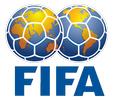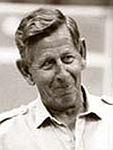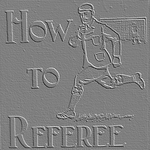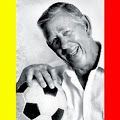 This Video from the... Ken Aston Referee Society -
This Video from the... Ken Aston Referee Society -
 Channel Channel

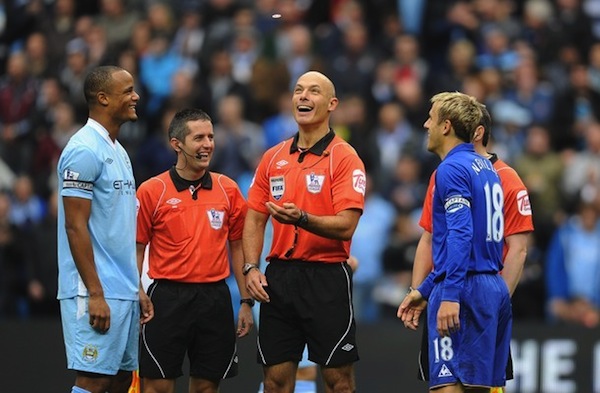 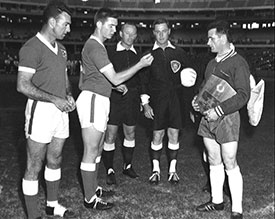  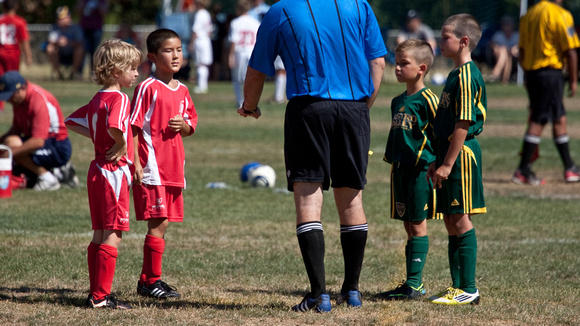 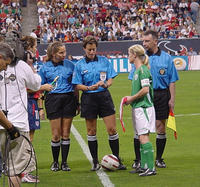
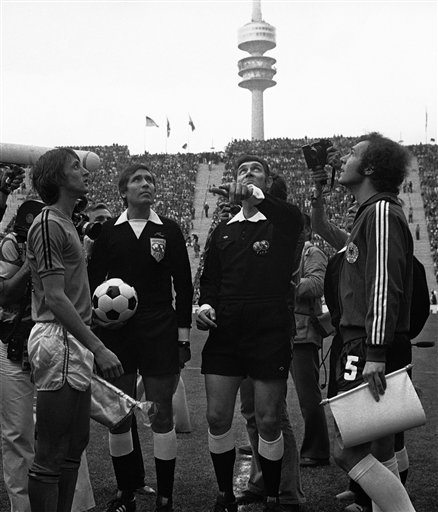
Preliminaries
A coin is tossed and the team, which wins the toss, decides which goal
it will attack in the first half of the match.
The other team takes the kick-off to start the match.
The team, which wins the toss, takes the kick-off to start the second
half of the match.
In the second half of the match the teams change ends and attack the
opposite goals.
Kick-off
A kick-off is a way of starting or
restarting play:
 - At the start of the match
- At the start of the match
 - After a goal has been scored
- After a goal has been scored
 - At the start of the second half of the match
- At the start of the second half of the match
 - At the start of each period of extra time, where applicable
- At the start of each period of extra time, where applicable
 - A goal may be scored directly from the kick-off.
- A goal may be scored directly from the kick-off.
Procedure
 - All players are in their own half of the field
- All players are in their own half of the field
 - The opponents of the team taking the kick-off are at least 9.15 m (10
yds) from the ball until it is in play
- The opponents of the team taking the kick-off are at least 9.15 m (10
yds) from the ball until it is in play
 - The ball is stationary on the center mark
- The ball is stationary on the center mark
 - The referee gives a signal
- The referee gives a signal
 - The ball is in play when it is kicked and moves forward
- The ball is in play when it is kicked and moves forward
 - The kicker does not touch the ball a second time until it has touched
another player
- The kicker does not touch the ball a second time until it has touched
another player
 - After a team scores a goal, the other team takes the kick-off.
- After a team scores a goal, the other team takes the kick-off.
Infringements/Sanctions
If the kicker touches the ball a
second time before it has touched another player:
 - An indirect free kick is awarded to the opposing team to be taken from
the place where the infringement occurred.
- An indirect free kick is awarded to the opposing team to be taken from
the place where the infringement occurred.
For any other infringement of the
kick-off procedure:
 - The kick-off is retaken
- The kick-off is retaken
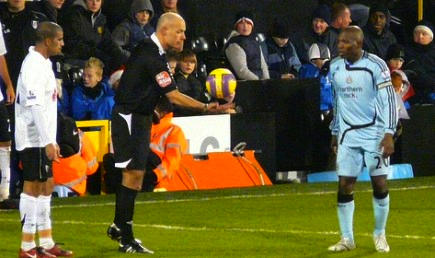 |
Dropped Ball
A dropped ball is a way of restarting the match after a
temporary stoppage, which becomes necessary, while the ball is
in play, for any reason not mentioned elsewhere in the Laws of
the Game. |
Procedure
The referee drops the ball at the place where it was located when play
was stopped.
Play restarts when the ball touches the ground.
Infringements/Sanctions
The ball is dropped again:
 - If it is touched by a player before it makes contact with the ground
- If it is touched by a player before it makes contact with the ground
 - If the ball leaves the field of play after it makes contact with the
ground, without a player touching it
- If the ball leaves the field of play after it makes contact with the
ground, without a player touching it
Special Circumstances
A free kick awarded to the defending team inside its own goal area is
taken from any point within the goal area.
An indirect free kick awarded to the attacking team in its opponents'
goal area is taken from the goal area line parallel to the goal line at
the point nearest to where the infringement occurred.
A dropped ball to restart the match after play has been temporarily
stopped inside the goal area takes place on the goal area line parallel
to the goal line at the point nearest to where the ball was located when
play was stopped.
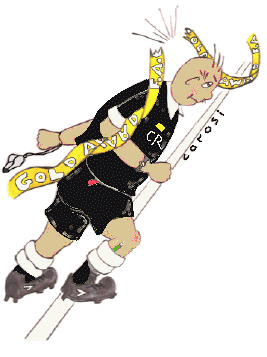 |
1. Preliminaries
2. Kick-off
3. Kick-off Procedure
4. Infringements/Sanctions
5. Dropped Balls Laws 5/8
6. Special Circumstances
7. Positioning
Questions and Answers: |
COMMON ELEMENTS OF THE EIGHT METHODS OF
RESTARTING PLAY
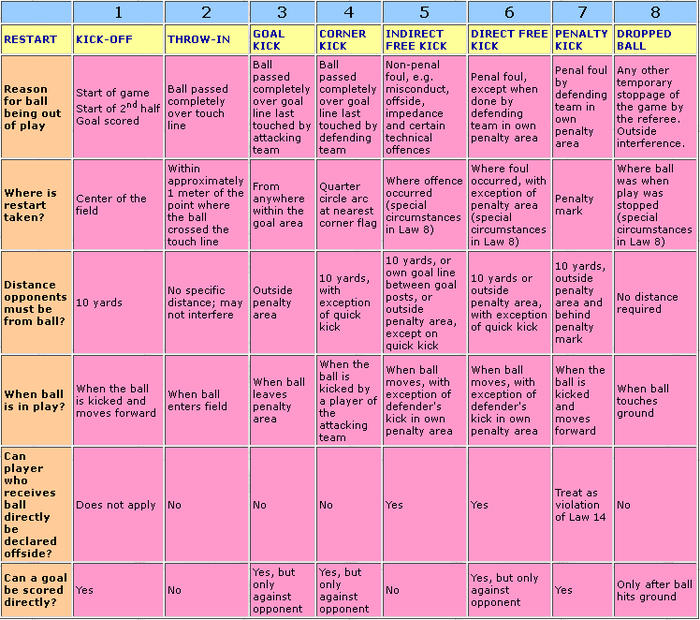
1. Preliminaries
Make sure you allow plenty of time to complete the coin tossing ceremony
prior to kick-off time.
It is very important that you create a calm and confident impression by
positively summoning the team Captains to the center-circle with a loud
and confident blow of your whistle - make sure everyone hears it. Be
pleasant in your manner to the Captains, wish them well and be sincere.
A feeble whistle at this stage will demonstrate a weakness to the
players - they will probably think:
Weakness with the whistle is one of the easiest ways to lose the
confidence of the players.
Make sure your bearing is positive and exudes confidence - this will
form a good impression for any on-looking players. Test your whistle at
home and in the changing room before you enter the field of play.
Shake the hands of both Captains and introduce yourself and your
Assistant Referees.
If you want to say anything to the Captains - this is the time to do it
- before you have tossed the coin. Do not be afraid of mentioning any
particular points you wish to emphasize, and tell the Captains that you
expect the game to be played in a good sporting manner.
A coin is tossed and the team that wins the toss decides which goal it
will attack in the first half of the match.
The other team takes the kick-off, to start the match. Use your
Referee's note pad to annotate which team kicked-off in the first half.
It is very easy to forget which team should kick-off, when coming out to
commence the second half,
The team that wins the toss takes the kick-off to start the second half
of the match.
In the second half of the match the teams must change ends and attack
the opposite goals.
In Cup Competitions, if extra time is required, then the coin is tossed
again - the team that wins the toss decides which goal it will attack in
the first half of the extra time, the other team takes the kick-off.
Make sure you have a coin available with you when you meet the Captains
in the center-circle. As a last resort (e.g. if you have left your coin
in the changing rooms) pick up one piece of grass and hide it behind you
in a closed fist - then ask one of the Captains to chose which hand is
holding the piece of grass, if he guesses correctly, then he wins and
chooses which goal his team will attack in the first half of the match.
It may sound stupid, but believe me, most Referees have used this method
more than once during their careers.
A good tip is to wear a wrist lanyard that includes the match whistle, a
spare whistle, and two small coins clipped onto the lanyard. Drill small
holes in each coin to allow clipping to the lanyard. You then have
everything secured and to hand. It also prevents that scourge of all
Referees - having a jangling coin jumping about in one of your pockets
and distracting you throughout the game.
Before you start the game, check that your Assistant Referees are in
position, and that all the players including the goalkeepers are ready
to start. Commence the game with a loud, clear, firm positive whistle.
Prior to the start of each half, most Referees hold out an up-stretched
arm towards the Assistant Referees and goalkeepers, to ask them if they
are ready to start. This is not necessarily required - a Referee can
usually see when everyone is ready.
2. Kick-off
A kick-off is a way of starting or restarting play:
 - At the start of the match
- At the start of the match
 - After a goal has been scored
- After a goal has been scored
 - At the start of the second half of the match
- At the start of the second half of the match
 - At the start of each period of extra time, where applicable
- At the start of each period of extra time, where applicable
Do not turn your back when a goal has just been scored;
keep your eyes
on the goal area to note
any misdemeanors occurring immediately
following the scoring of the goal.
Walk or run backwards to the center-circle, keeping your eyes on the
players involved.
Once players have settled down
.
3. Kick-off Procedure
 - All players must be in their own half of the field
- All players must be in their own half of the field
 - The opponents of the team taking the kick-off must be at least 9.15 m
(10 yds) from the ball until it is in play, i.e. the players must be
outside of the center-circle and must not encroach until the kick-off
has taken place
- The opponents of the team taking the kick-off must be at least 9.15 m
(10 yds) from the ball until it is in play, i.e. the players must be
outside of the center-circle and must not encroach until the kick-off
has taken place
 - The ball must be stationary and on the center mark
- The ball must be stationary and on the center mark
 - The referee gives a signal for the team to restart play (it is not
essential to blow your whistle to restart after a goal has been scored,
you can just signal or speak or shout. Example " Off you go lads".)
- The referee gives a signal for the team to restart play (it is not
essential to blow your whistle to restart after a goal has been scored,
you can just signal or speak or shout. Example " Off you go lads".)
But blow your whistle loudly to commence the start of each half.
 - The ball is in play as soon as it is kicked and moves forward into the
opponents half. The opponents can only then enter the center-circle.
- The ball is in play as soon as it is kicked and moves forward into the
opponents half. The opponents can only then enter the center-circle.
 - The kicker must not touch the ball a second time until it has touched
another player
- The kicker must not touch the ball a second time until it has touched
another player
After a team scores a goal, the other team takes the kick-off.
The normal position of the Referee prior to a kick-off is on the
Referee's diagonal, which he is to patrol, just outside of the
center-circle, and facing the team who are taking the kick-off. This
position can vary, but do try and keep away from the action area. In
other words, do not get in the way of the players during a kick-off -
but allow yourself a good view of the kick-off.
During kick-off, Assistant Referees will normally position themselves so
that they are adjacent to the last outfield defender, in readiness to
judge for any off sides. This will prevent them having to suddenly
sprint to monitor any offside offence at the commencement of the game,
and therefore reduce the risk of a pulled muscle or other injuries
before they have had time to warm up.
4. Infringements/Sanctions
If the kicker touches the ball a second time before it has touched
another player:
 - An indirect free kick is awarded to the opposing team to be taken from
the place where the infringement occurred
- An indirect free kick is awarded to the opposing team to be taken from
the place where the infringement occurred
 - A direct free kick is awarded if the player touches the ball a second
time with his hands
- A direct free kick is awarded if the player touches the ball a second
time with his hands
For any other infringement of the kick-off procedure:
 - The kick-off is retaken
- The kick-off is retaken
For example:
 - If the ball was in the opponents half when the kick-off was taken -
retake the kick-off
- If the ball was in the opponents half when the kick-off was taken -
retake the kick-off
 - If a player involved with the kick-off is standing inside his
opponents half- retake the kick-off
- If a player involved with the kick-off is standing inside his
opponents half- retake the kick-off
 - If a player not involved with the kick-off is standing inside his
opponents half- retake the kick-off
- If a player not involved with the kick-off is standing inside his
opponents half- retake the kick-off
 - If the opposition are not all in their own half - retake the kick-off
- If the opposition are not all in their own half - retake the kick-off
5. Drop Balls
A. Dropped-Ball
re-start:
B. Dropped Ball Procedure:
C. Dropped Ball Infringements/Sanctions: |
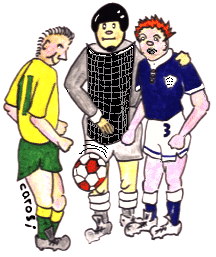 |
A. Dropped-Ball re-starts:
A dropped ball is a way of restarting the match after a temporary
stoppage that becomes necessary, while the ball is in play - for any
reason not mentioned elsewhere in the Laws of the Game. It is also the
method of restarting play, when play has been stopped by the Referee
because of an action occurring outside of the field of play (external
interference).
For example, if the Referee needs to stop play due to a spectator or dog
entering onto the pitch, or when the ball suddenly becomes deflated -
play will be restarted with a dropped ball.
 - If a goalkeeper has been obviously injured in a fair tackle with an
opponent, and the goalkeeper still has possession of the ball in his
hands but is obviously unable to continue playing - stop play to allow
treatment. Restart play by just dropping the ball back to the goalkeeper
when he has recovered. - If a goalkeeper has been obviously injured in a fair tackle with an
opponent, and the goalkeeper still has possession of the ball in his
hands but is obviously unable to continue playing - stop play to allow
treatment. Restart play by just dropping the ball back to the goalkeeper
when he has recovered.
There is nowhere in the Laws which stipulate that you must have two
players to complete a dropped ball restart!
A dropped ball may sometimes be used to start a charity match where both
of the teams are not really competing against each other. It is also
sometimes used instead of a place kick in some 6-a-side competitions
etc.
In dropped ball situations, the restart takes place where the ball was
when you stopped play. If the game is stopped when the ball is inside a
goal area - restart with a dropped ball on the line marking the outer
edge of the goal area, parallel to the goal line at a point nearest to
where the ball was in play.
If you (the Referee) have to stop the game because of external (outside
of the game) interference, then note position of the ball when the game
was stopped; you will need to remember how and where to re-start the
game !!!!!!!. It is very easy to remain focused on the cause of the
external interference, and then forget where the ball was when you
stopped play.
IT IS VERY EASY TO FORGET WHERE THE BALL WAS WHEN YOU STOPPED PLAY!!!
If the ball was out of play when you stopped the game, use the
appropriate restart, i.e. goal kick, throw-in etc.....
When the ball is still in play, any offences committed by players on the
actual field of play against teammates or encroaching officials,
coaches, and spectators, must be restarted with the award of an indirect
free kick to the opposing team. If the misconduct occurred off the field
of play whilst the ball was still in play, the restart should be a
dropped ball at the place where the ball was when the Referee stopped
play.
If when a ball is about to cross over the goal line for a goal, it is
stopped or deflected towards goal by an outside agent such as a dog, or
a spectator, then you must award a DROPPED BALL at the place where the
incident occurred. (Except in the goal area - then drop the ball on the
nearest point of the goal area line which runs parallel to the goal
line.) At park level games, it is not unusual to have spectators
standing very close to the goal posts, who have been know to deflect the
ball into the goal by placing a foot into the field of play - or
conversely, to even prevent a goal.
If the ball deflects off a dog and then goes into the goal - the goal
does not count. This is external interference, and a dropped ball is the
correct method for restarting the game.
B.Dropped Ball Procedure:
 - The Referee drops the ball at
the place where it was located when play was stopped. The
Referee should not bounce or throw the ball up in the air. The
ball should simply be released from no more than waist level and
allowed to fall naturally to the ground.
- The Referee drops the ball at
the place where it was located when play was stopped. The
Referee should not bounce or throw the ball up in the air. The
ball should simply be released from no more than waist level and
allowed to fall naturally to the ground.
 - There is always the chance that during the taking of a dropped
ball, the ball will be kicked upwards towards the Referee, so do
not leave the whistle in your mouth during dropped balls. Once
you have dropped the ball, make a hasty getaway. If the players
are 'fired-up', have a word with them first, and say to them "I
don’t want any broken legs please, and let the ball touch the
ground!!!"
- There is always the chance that during the taking of a dropped
ball, the ball will be kicked upwards towards the Referee, so do
not leave the whistle in your mouth during dropped balls. Once
you have dropped the ball, make a hasty getaway. If the players
are 'fired-up', have a word with them first, and say to them "I
don’t want any broken legs please, and let the ball touch the
ground!!!"
 -
If play has been temporarily stopped inside the goal area, the
dropped ball takes place on the goal area line parallel to the
goal line at the point nearest to where the ball was located
when play was stopped.
-
If play has been temporarily stopped inside the goal area, the
dropped ball takes place on the goal area line parallel to the
goal line at the point nearest to where the ball was located
when play was stopped.
 -
Play restarts when the ball touches the ground.
-
Play restarts when the ball touches the ground. |
 |
C. Dropped Ball
Infringements/Sanctions:
The ball is dropped again:
 - If during a dropped ball, a player makes contact with the ball before
it has touched the ground. (A player, who repeats this offence, must be
warned or cautioned for unsporting behavior.
- If during a dropped ball, a player makes contact with the ball before
it has touched the ground. (A player, who repeats this offence, must be
warned or cautioned for unsporting behavior.
 - If the ball leaves the field of play after it makes contact with the
ground, without a player touching it
- If the ball leaves the field of play after it makes contact with the
ground, without a player touching it
During a drop-ball situation, the ball is in play as soon as it has
touched the ground.
The Referee is advised to stand well clear as soon as possible during a
dropped-ball situation.
Have a word with the players first, and say to them "I don’t want any
broken legs please!!!"
It is not unusual during a game, for the ball to become entangled
between player’s legs, or wedged between players who have fallen onto
the ground. This could be dangerous to players. If the ball becomes
inadvertently trapped beneath a player (or players). Play should be
stopped immediately and restarted with a dropped ball. Stopping play in
this instance will undoubtedly prevent unnecessary injury to players.
The Referee should not expect players' to stop of their own accord -
when a ball becomes trapped beneath players on the ground - the Referee
must make a quick decision to stop play. In such situations, it is not
uncommon to see three or four players all attempting to kick the ball at
the same time. In the 'heat' of a football match, players can lose all
sense of decorum, and have even been known to kick violently at the ball
when it is near the head of a prostrate player. This is not necessarily
done on purpose to injure that player - the speed of the modern game is
such that actions to gain possession of the ball can be done a split
second and instinctively. Nevertheless, the Referee should send off any
player who he believes has purposefully endangered (or injured) a player
lying on the floor, by committing a violent act or serious foul play
when attempting to gain the ball.
The Referee can consider awarding an indirect free kick if a player
lying on the floor is challenged in such a way that the challenging play
is deemed to be dangerous. For example, if the ball is positioned very
near the head of the player lying on the floor, and an opponent makes a
rash attempt to kick the ball, then this could certainly be deemed to be
dangerous play. A player does not have to be standing up for dangerous
play to be committed against him!
If a crossbar becomes displaced or broken, play is stopped until it has
been repaired or replaced in position. If a repair is not possible, the
match is abandoned. The use of a rope to replace the crossbar is not
permitted. If the crossbar can be repaired, the match is restarted with
a dropped ball at the place where the ball was located when play was
stopped.
If there are any head injuries during the game, the Referee should stop
play immediately and seek treatment. The restart is a dropped ball, at
the location where the ball was when the Referee stopped play.
If the ball bursts - the restart is a dropped ball. But don't drop the
'bust ball'! Find a new one!

6. Special Circumstances
A free kick awarded to the defending team inside its own goal area can
be taken from any point within the goal area.
An indirect free kick awarded to the attacking team in its opponents'
goal area is taken from the goal area line parallel to the goal line at
the point nearest to where the infringement occurred.
7. Positioning:
 - A place kick is the
method of starting a game. It is also used after a team scores a
goal (the kick-off is taken by the non-scoring team).
- A place kick is the
method of starting a game. It is also used after a team scores a
goal (the kick-off is taken by the non-scoring team).
 -
Before summoning the two captains at the start of the game, and
to complete the 'coin tossing' ceremony, the Referee should
position himself in the center circle on the halfway line Fig. 2
position (1), facing towards the far touchline.
-
Before summoning the two captains at the start of the game, and
to complete the 'coin tossing' ceremony, the Referee should
position himself in the center circle on the halfway line Fig. 2
position (1), facing towards the far touchline.
 -
Assuming that the round team is taking the place kick, the
Referee should then place himself at position (2). Because the
round team have the ball, they are more likely to retain
possession and attack the square team goal. The Referee should
therefore position himself in anticipation of the ball making
its way into the square team's half, and having the Assistant
Referee in the (top right hand corner) in his line of sight as
shown by the arrow.
-
Assuming that the round team is taking the place kick, the
Referee should then place himself at position (2). Because the
round team have the ball, they are more likely to retain
possession and attack the square team goal. The Referee should
therefore position himself in anticipation of the ball making
its way into the square team's half, and having the Assistant
Referee in the (top right hand corner) in his line of sight as
shown by the arrow.
 -
Position (3) can be taken if the Referee believes that the ball
will be played all the way back to the round team’s defense.
-
Position (3) can be taken if the Referee believes that the ball
will be played all the way back to the round team’s defense.
 -
During place kicks from the center spot, Assistant Referees
should position themselves so that they are adjacent to the
second last defender, in readiness to judge for any offside.
-
During place kicks from the center spot, Assistant Referees
should position themselves so that they are adjacent to the
second last defender, in readiness to judge for any offside.
 -
This will prevent the Assistant Referee from having to suddenly
sprint to monitor any offside offences at the commencement of
the game, and therefore reduce the risk of injury before they
have had time to warm up properly.
-
This will prevent the Assistant Referee from having to suddenly
sprint to monitor any offside offences at the commencement of
the game, and therefore reduce the risk of injury before they
have had time to warm up properly.
 -
The normal position for the Referee prior to a kick-off, is on
the Referee's diagonal which he is to patrol, just outside of
the center-circle, and facing the team who are taking the
kick-off - and away from the vicinity any congregated players.
-
The normal position for the Referee prior to a kick-off, is on
the Referee's diagonal which he is to patrol, just outside of
the center-circle, and facing the team who are taking the
kick-off - and away from the vicinity any congregated players.
 -
This position can vary slightly, but do try and keep away from
the action area.
-
This position can vary slightly, but do try and keep away from
the action area.
 -
In other words, do not get in the way of the players during a
kick-off - but allow yourself a good view of the center circle
action area. The Referee should aim to stand just outside of the
center circle.
-
In other words, do not get in the way of the players during a
kick-off - but allow yourself a good view of the center circle
action area. The Referee should aim to stand just outside of the
center circle.
 -
It is important for the Referee to project himself as a figure
of authority.
-
It is important for the Referee to project himself as a figure
of authority.
 -
Any weakness shown before the game has commenced will give the
wrong signal to players and coaches. Referees should ensure that
there is plenty of time to complete the coin tossing ceremony
prior to kick-off time.
-
Any weakness shown before the game has commenced will give the
wrong signal to players and coaches. Referees should ensure that
there is plenty of time to complete the coin tossing ceremony
prior to kick-off time.
I - t is very important to create a calm and confident impression
by positively summoning the team Captains to the center-circle
with a loud and confident blow of the whistle - "make sure
everyone hears it".
- t is very important to create a calm and confident impression
by positively summoning the team Captains to the center-circle
with a loud and confident blow of the whistle - "make sure
everyone hears it".
 -
A quiet whistle at this stage will demonstrate a weakness to the
players - they will probably think:
-
A quiet whistle at this stage will demonstrate a weakness to the
players - they will probably think:
 -
"We have a 'right one' here this week".
-
"We have a 'right one' here this week".
 -
Weakness with the whistle is one of the easiest ways to lose the
confidence of the players. Be pleasant in your manner to the
Captains, be sincere, and say "Enjoy the game"
-
Weakness with the whistle is one of the easiest ways to lose the
confidence of the players. Be pleasant in your manner to the
Captains, be sincere, and say "Enjoy the game"
 -
Make sure your bearing is positive and exudes confidence - this
will form a good impression for any on-looking players. Test
your whistle at home and before you enter the field of play.
-
Make sure your bearing is positive and exudes confidence - this
will form a good impression for any on-looking players. Test
your whistle at home and before you enter the field of play.
 -
On entering the field of play, the Referee should be smartly
dressed, and walk towards the center circle in an upright and
confident manner. The ball should be carried (and definitely not
dribbled) and placed on the center spot in readiness for the
coin tossing
-
On entering the field of play, the Referee should be smartly
dressed, and walk towards the center circle in an upright and
confident manner. The ball should be carried (and definitely not
dribbled) and placed on the center spot in readiness for the
coin tossing |
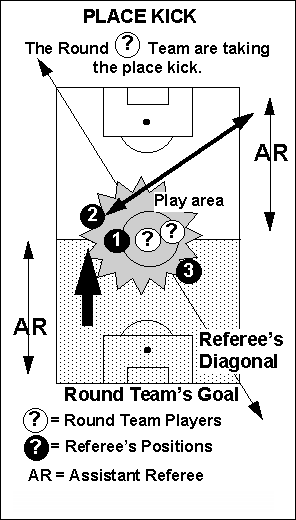
 |
+-+ BACK TO TOP +-+
+-+ FIFA-ADDITIONAL +-+
+-+ ADVICE from 'THE PITCH' +-+
Questions and Answers:
This web site and the advice and answers to any questions are not
sanctioned by or affiliated with any governing body of soccer. The
opinions expressed on this site should not be considered official
interpretations of the Laws of the Game. Although the content of the
latest Laws are included on this site, the majority of the content is
the opinion of the Webmaster and other Referees worldwide. If you need
an official ruling you should contact your local
representative/association or visit the FIFA, or the English FA web
sites for the Laws themselves.
Questions and Answers:
Question 1: Is anyone else
apart from the players allowed to take the kick-off in a match?
Answer 1: No. If it is agreed in a 'charity' type match, that the
kick-off will be taken by a celebrity or a child (someone not taking
part in the match) then the ball must be brought back to the center spot
and the kick-off retaken in accordance with the Laws of the Game.
Question 2: During restarts
of play, is it legal for a player to put his foot on the top of the ball
and touch it so that it starts moving forward and then roll it backwards
all in the same movement without having taken his foot off the ball?
Answer 2: During a restart, the ball is only in play when it is kicked
and moves. In this case, the ball is not actually kicked but rolled
forwards and then backwards in one movement. The player did not touch
the ball a second time, because he did not take his foot off the surface
of the ball - it was all done with one touch and not two - so an
indirect free kick to the opposition is not an option. The kick should
be retaken properly.
In instances such as this, the Referee should endeavor to educate
players on the correct procedure to be used. Tell them that "the ball
must be kicked and moved before it is deemed in play, and then someone
else needs to play it before the kicker touches it again”. Educating is
particularly important when teaching our younger players how it should
properly be done.
Question 3: Does the Referee
have to 'toss the coin' again before any extra time is played?
Answer 3: Yes. The procedure used is the same as when the match is
started in normal time. A coin is tossed, and the team who wins the toss
decides which goal it will attack in the first half period of extra
time. The other team then takes the kick-off. The team that wins the
toss at extra time kicks off to start the second period of extra time.
Question 4: Exactly what does
go on at the coin tossing ceremony at the start of the match?
Answer 4: Referees have their own methods on conducting this procedure.
But generally, the procedure is done to cover the following points:
 -
(a) It allows the Referee to identify both of the team captains and
shake their hands. This is an important piece of man-management on
behalf of the Referee. Don't offer the captains a hand that simulates a
'wet fish'. Give them a strong, firm handshake - this tells them that
you mean business. I also make a note of both of the captains' numbers
in my notebook. This has proved invaluable in the past when I need to
talk to them during the game, but I can't remember what they look like.
-
(a) It allows the Referee to identify both of the team captains and
shake their hands. This is an important piece of man-management on
behalf of the Referee. Don't offer the captains a hand that simulates a
'wet fish'. Give them a strong, firm handshake - this tells them that
you mean business. I also make a note of both of the captains' numbers
in my notebook. This has proved invaluable in the past when I need to
talk to them during the game, but I can't remember what they look like.
Is it I, or do all footballers look alike?
When blowing to call the two captains towards the center circle for the
tossing of the coin ceremony, blow the cobwebs out from your whistle.
Don't use a week ‘peep’; give them a loud shrill blast - this also tells
them that you mean business!
 -
(b) The Referee should introduce himself and any Assistant Referees to
the captains (there is no need to introduce Club Linesmen but you can do
so if you wish). Introduce the Assistant Referees by first (Christian)
names. The Referee does not normally introduce himself by name, but can
do so if he wants. The introduction of the Assistant Referees shows the
players that there is three match officials out there, working as a
team.
-
(b) The Referee should introduce himself and any Assistant Referees to
the captains (there is no need to introduce Club Linesmen but you can do
so if you wish). Introduce the Assistant Referees by first (Christian)
names. The Referee does not normally introduce himself by name, but can
do so if he wants. The introduction of the Assistant Referees shows the
players that there is three match officials out there, working as a
team.
 -
(c) This meeting also allows the Referee to impart any words of wisdom -
should he wish to do so! Some Referees read the captains a 'bed time
story’; others say nothing more than 'Hello'. Some Referees give special
instructions about the way the game will be officiated to the captains,
allowing them to pass this information onto their managers, coaches and
teammates.
-
(c) This meeting also allows the Referee to impart any words of wisdom -
should he wish to do so! Some Referees read the captains a 'bed time
story’; others say nothing more than 'Hello'. Some Referees give special
instructions about the way the game will be officiated to the captains,
allowing them to pass this information onto their managers, coaches and
teammates.
What is said is up to the individual Referee. There is no stipulation to
say anything. But Referees are encouraged to think of something to say
(if only "keep the swearing down lads"). It is important that Referees
don't start off on the wrong foot, by giving the captains an impression
that they (the Referee) are 'a miserable old duffer!'. Try at least to
look interested in what you are doing - and put a smile on your face,
because this is probably the only moment you will feel like doing so
once the game gets going!
 -
(d) Tossing the coin: There are many ways to do this. Some Referees let
the Away captain toss and drop the coin to the ground, some let the Home
team captain toss the coin and catch it. Some Referees toss the coin
themselves and catch it, and then ask the Away captain to guess.
Whatever system you use, use it consistently in all of your matches.
Having lost a few coins during my 'baptism' as a new Referee many years
ago, I always toss and catch the coin myself, and give the Away captain
the option of calling 'heads or tails'. My coins have a hole drilled
into them, and are clipped to my wrist lanyard for safety. I've been
using the same coin now for over 6 years. The captain, who wins the
toss, chooses ends, and the other captain's team take the kick-off. If
there are any local conventions such as "home" team tosses and "away"
team calls, then the Referee should follow the expected procedure.
-
(d) Tossing the coin: There are many ways to do this. Some Referees let
the Away captain toss and drop the coin to the ground, some let the Home
team captain toss the coin and catch it. Some Referees toss the coin
themselves and catch it, and then ask the Away captain to guess.
Whatever system you use, use it consistently in all of your matches.
Having lost a few coins during my 'baptism' as a new Referee many years
ago, I always toss and catch the coin myself, and give the Away captain
the option of calling 'heads or tails'. My coins have a hole drilled
into them, and are clipped to my wrist lanyard for safety. I've been
using the same coin now for over 6 years. The captain, who wins the
toss, chooses ends, and the other captain's team take the kick-off. If
there are any local conventions such as "home" team tosses and "away"
team calls, then the Referee should follow the expected procedure.
 -
(e) This opportunity also allows Referees the opportunity of 'spreading
out their feathers'. Don't enter the field of play with your socks
rolled down, dribbling the ball, and with a cigarette stub hanging out
from your mouth. First impressions are very important. Enter the field
of play positively, dressed smartly, carrying the ball, shoulders back
and authoritative. Players are very adept at spotting and playing on any
weaknesses shown by Referees.
-
(e) This opportunity also allows Referees the opportunity of 'spreading
out their feathers'. Don't enter the field of play with your socks
rolled down, dribbling the ball, and with a cigarette stub hanging out
from your mouth. First impressions are very important. Enter the field
of play positively, dressed smartly, carrying the ball, shoulders back
and authoritative. Players are very adept at spotting and playing on any
weaknesses shown by Referees.
 -
(f) The Referee also uses this period to count the number of players in
both teams before the beginning of each half. The Referee's signal to
start the second half is an acknowledgement that the persons on the
field of play are legal players and the persons wearing a goalkeeper
jersey are the goalkeepers. A note in the Referee's note book showing
which team kicks-off in the first half, is also a good idea, and
prevents embarrassment when coming out for the second half, and the
players ask you (the Referee) which team kicks-off - and you can't
remember! (This has happened to me on a number of occasions!!!) The
Referee does not have to put his hand up to each Assistant and each
goalkeeper, to acknowledge their attention before the start of each
half. My view is that these signals (used before commencement of play by
the Referee) are a bit too crass for my liking. There is nothing wrong
with just looking at each of them, to ensure they are ready before you
blow your whistle to commence play.
-
(f) The Referee also uses this period to count the number of players in
both teams before the beginning of each half. The Referee's signal to
start the second half is an acknowledgement that the persons on the
field of play are legal players and the persons wearing a goalkeeper
jersey are the goalkeepers. A note in the Referee's note book showing
which team kicks-off in the first half, is also a good idea, and
prevents embarrassment when coming out for the second half, and the
players ask you (the Referee) which team kicks-off - and you can't
remember! (This has happened to me on a number of occasions!!!) The
Referee does not have to put his hand up to each Assistant and each
goalkeeper, to acknowledge their attention before the start of each
half. My view is that these signals (used before commencement of play by
the Referee) are a bit too crass for my liking. There is nothing wrong
with just looking at each of them, to ensure they are ready before you
blow your whistle to commence play.
Question 5: Can a team send
more than one person (captain) to participate in the 'tossing the coin'
ceremony at the start of a match?
Answer 5: There is no mention in the Laws to specify how many captains a
team may send up to the 'tossing of the coin' ceremony. But it would
look a bit daft if more than one captain was nominated. One captain
should be designated this task. Another main function of a designated
captain is to be the authorized intermediary to ask questions of the
Referee during the game. It does no good to have a team of eleven
captains to officiate - although in most games, this is exactly what the
Referee has to put up with! However, captains have no special rights to
show dissent towards the Referee, or to have the game stopped for
clarification. Coaches and managers may sometimes use their captain as a
diplomatic intermediary, when it seems better to not speak directly to
the Referee themselves. In my experience, no matter how a Referee tries
to encourage the captains to take some responsibility for their own
players - the captains end up being the worse perpetrators of bad
behavior. I've given up trying to ask for their assistance during the
'tossing up of the coin ceremony’; it's just a complete waste of time.
Question 6: Both the Referee
and the Assistant Referee were unfortunately blocked off from view when
the ball crosses the touchline for a throw-in. Neither of the officials
was sure, of which way the throw should be awarded. The Referee decided
to award a dropped ball instead - is this correct?
Answer 6: No. Law 8 states that a dropped ball is the correct method of
restarting the game after a temporary stoppage for any reason not
mentioned elsewhere in the Laws of the Game. In this instance, the ball
crossed the touchline - so the correct restart in accordance with Law 15
(The Throw-in) is a throw-in! No other restart is permitted. The Referee
does not have the authority to restart with a dropped ball, merely
because he is uncertain about which way the throw should be awarded.
There will be many times during a Referees career, that both he and/or
his Assistants will not be sure on the direction that a throw should be
awarded. The solution is very simple - and one that has worked for me
(and most other Referees) over many years. If you are unsure as to the
direction of a throw, use the 'rule-of-thumb' method and always award it
to the defending team. Don't worry too much if you have made the correct
decision or not (this applies to Assistant Referees as well as
Referees). The secret is to be very positive and 'stick to your guns'.
Indicate with a strong arm and whistle signal. If you get any dissent,
re-signal as before, but tell the players to "GET ON WITH IT". It is
very important that you use a consistent method and get into this frame
of mind before each game. You will be surprised how easy and
automatically you make such decisions after you have tried it once or
twice. Throw-ins are not goal scoring opportunities, so don't fret about
making a wrong decision - it very rarely affects the outcome of a game.
Some Referees award uncertain direction throws to the attacking side -
whatever method you use - be consistent.
As always with football, there are exceptions - some USA high-school
rules specifically permit a dropped ball, five yards from the touchline,
if the Referee can't determine which team should be awarded a throw-in.
This is not part of the official Laws, and should not be used elsewhere.
Question 7: During a shot on
goal that is going wide, the goalkeeper moves backwards and catches the
ball just as it is about to cross the goal line outside of the goal
post. The Assistant Referee automatically signals for a corner kick but
then realizes that the ball has not actually crossed the line when being
caught by the goalkeeper. The Referee, who fleetingly sees the Assistant
Referees signal out of the corner of his eye, blows and signals for a
corner. However, the defending team complains to the Referee, that the
ball had not wholly crossed the goal line. The Referee converses with
his Assistant Referee - who acknowledges that he had made a mistake by
signaling too soon, and the ball had not actually crossed over the goal
line, and play should have been allowed to continue. The Referee than
decides that a corner is not the correct decision. How should the
Referee restart the game?
Answer 7: The Referee had
stopped the game, so some form of restart is required. Once again, the
'old' dropped ball comes to the rescue. Law 8 states that a dropped ball
is the correct method of restarting the game after a temporary stoppage
for any reason not mentioned elsewhere in the Laws of the Game. In this
instance, a dropped ball is the correct restart method. The dropped ball
takes place on the goal line parallel to where the goalkeeper was
standing on his goal line when he caught the ball in his goal area. Law
8 does not stipulate a minimum or maximum number of players required for
a dropped ball. All the Referee needs to do is to ensure that the
offensive team back off and simply drop the ball to the goalkeeper for
the restart. Easy isn't it!!! We all make mistakes, and players are
always receptive to a bit of common sense in such circumstances.
Assistant Referees should not anticipate the ball going out of play. It
is always better to have a late and correct flag signal than to flag too
quickly and make a mistake.
As a general rule, if the Referee mistakenly blows the whistle to stop
play for whatever reason, the proper restart is a dropped ball at the
place where the ball was when the whistle was blown.
Question 8: During a match, a
defender falls injured to the ground near his goal after passing the
ball to a colleague who is in a good position to clear the ball away.
The Referee decides to stop the game immediately because of the injury.
The correct restart is a dropped ball - but this gives an unfair
advantage to the attacking side. Is there an alternative restart that
will pass the advantage back fairly to the defending team?
Answer 8: No. The correct restart is a dropped ball at the position the
ball was when play was stopped.
Experienced Referees will try to avoid situations like this, by letting
play continue for a few seconds until the ball is cleared out of play,
or away from the vicinity of the goal, before stopping the game.
However, if the Referee thinks that the injury is serious, then he
should stop the game immediately (for example - a head injury).
Law 8 does not stipulate a minimum or maximum number of players required
for a dropped ball. All the Referee needs to do is to ensure that the
offensive team back off and simply drop the ball to the goalkeeper or a
defender for the restart.
The Referee's judgment of whether an advantage should be given to the
defending team or the attacking team, depends on the situation at the
time the Referee stopped play. There may be occasions when the attacking
team has possession of the ball when the Referee temporarily suspends
play. In such cases a proper dropped ball with both teams involved would
be the appropriate method of restart. Deciding advantage is entirely a
matter for the Referee's discretion.
If in the above situation, the Referee decides to award a standard
dropped ball, where a player from both teams participate - and the
Referee has asked the attacking player to pass the ball back gently to
the defending goalkeeper - but instead, after the ball has touched the
ground, the attacker volleys the ball into the net for a goal - there is
not much the Referee can do, and the goal must count. The Referee has no
power in this situation to force the attacking team to engage in
sporting behavior, or to instruct players not to participate in a
dropped ball - but this is the correct thing to do, taking into account
the spirit of the game under certain circumstances. My advice is to
forget about asking attacking players to participate, just drop the ball
to the goalkeeper - it will save you a great deal of trouble - and is
certainly within the 'spirit of the game'. Referees' are asking for
trouble giving the ball to an attacker and asking them to kick the ball
nicely to the defending keeper. Whereas most players will oblige, there
are some that will take advantage of such a situation. "Prevention is
better than cure".
Question 9: Is the kick-off a
direct free kick?
Answer 9: Yes, I suppose it is (but not in name). The only difference is
that the ball must be kicked and travel forwards. A Law change in the
1997/98 seasons allowed players (for the first time) to score direct
from the kick-off. This may sound a difficult task to complete, but I
have seen it done on several occasions, particularly when the goalkeeper
is standing on the edge of his penalty area, and an astute kicker
notices this, and lobs the ball directly over the goalkeeper from the
center spot and into the goal. Of course, the Referee must signal for
the kick-off to commence, before the players' are allowed to start the
kick-off - the Referee can do this in several ways, for instance, by
blowing his whistle, by a hand/arm signal or even by verbally speaking
to the players. (In the United States it is generally accepted that the
Referee signals for a kick-off with a whistle rather than any other
signal). If a team takes the kick-off before the Referee has signaled,
any directly scored goal will not count. Law 8 mandates that the
kick-off is retaken if it occurs without the Referee's signal.
Question 10: As a manager,
are there any considerations that I should take into account when
instructing my captains which end of the field we want to attack if we
win the coin toss?
Answer 10: There are several factors that you could take into
consideration:
 -
a. The location of your team spectators or the position of the technical
area or changing rooms may influence your decision.
-
a. The location of your team spectators or the position of the technical
area or changing rooms may influence your decision.
 -
b. The direction of the wind is an important factor. You may wish to
have a strong wind at your back in the first half. Most teams like to
play towards the wind and 'dig-in' during the first half. At least then
at half time you know what score you are up against, and the second half
should be easier with the wind at your backs. But the wind may die down
or change completely by second half.
-
b. The direction of the wind is an important factor. You may wish to
have a strong wind at your back in the first half. Most teams like to
play towards the wind and 'dig-in' during the first half. At least then
at half time you know what score you are up against, and the second half
should be easier with the wind at your backs. But the wind may die down
or change completely by second half.
 -
c. The position of the sun is also important, especially for the
goalkeepers. During an afternoon game, the sun will be higher in the
first half, and you should take the option of facing the sun. The sun
will drop lower in the second half, and will make it difficult for your
opponents to see balls being flighted towards them. Avoid having a low
sun directly in your goalkeeper's face or let your opponents face it
when it is relatively lower in the second half. Even the positioning of
surrounding trees, stands and buildings will affect the amount of light
reaching the field from the sun. All this must be taken into
consideration before deciding the best direction to attack in the first
half.
-
c. The position of the sun is also important, especially for the
goalkeepers. During an afternoon game, the sun will be higher in the
first half, and you should take the option of facing the sun. The sun
will drop lower in the second half, and will make it difficult for your
opponents to see balls being flighted towards them. Avoid having a low
sun directly in your goalkeeper's face or let your opponents face it
when it is relatively lower in the second half. Even the positioning of
surrounding trees, stands and buildings will affect the amount of light
reaching the field from the sun. All this must be taken into
consideration before deciding the best direction to attack in the first
half.
 -
d. The slope of the field of play is another important factor. Some
fields have quite an incline. Players generally like to play kicking 'up
the slope' in the first half. This allows them to get the worst part of
the game over, and concentrate on achieving a result in the second half.
Some teams seem to play better kicking up the slope, as it necessitates
more of a passing game, as opposed to just lumping the ball aimlessly
down the slope towards your opposition's goal, in the hope that a goal
scoring opportunity will materialize.
-
d. The slope of the field of play is another important factor. Some
fields have quite an incline. Players generally like to play kicking 'up
the slope' in the first half. This allows them to get the worst part of
the game over, and concentrate on achieving a result in the second half.
Some teams seem to play better kicking up the slope, as it necessitates
more of a passing game, as opposed to just lumping the ball aimlessly
down the slope towards your opposition's goal, in the hope that a goal
scoring opportunity will materialize.
 -
e. The condition of the field of play should be looked at. It is not
unusual for one half of the field to be in much better condition that
the other half. Such factors as puddles or muddy or soft areas that are
likely to get worse as the game proceeds, must be assessed. For example,
if one of the goal mouths has a small puddle in the center, and you know
that the rain is not going to stop during the game, then you should try
and place your goalkeeper in that goal during the first half, knowing
full well, that by the time the second half starts, that goal mouth will
become a marshy swamp - that the opposition goalkeeper will have great
difficulty with keeping his feet in position. On the other hand, if it
is likely that the weather will turn warm, dry and sunny by the second
half, you may want to do the opposite. Teams generally like to let their
defense cope with any problems in the first half, in the hope that by
the second half, the problem will have grown for the other side.
-
e. The condition of the field of play should be looked at. It is not
unusual for one half of the field to be in much better condition that
the other half. Such factors as puddles or muddy or soft areas that are
likely to get worse as the game proceeds, must be assessed. For example,
if one of the goal mouths has a small puddle in the center, and you know
that the rain is not going to stop during the game, then you should try
and place your goalkeeper in that goal during the first half, knowing
full well, that by the time the second half starts, that goal mouth will
become a marshy swamp - that the opposition goalkeeper will have great
difficulty with keeping his feet in position. On the other hand, if it
is likely that the weather will turn warm, dry and sunny by the second
half, you may want to do the opposite. Teams generally like to let their
defense cope with any problems in the first half, in the hope that by
the second half, the problem will have grown for the other side.
 -
f. Another area you may want to consider is how far the ball will roll,
when it is kicked off the field behind the goals. Some fields have long
slopes or house gardens to contend with immediately behind the goals. It
may be better for your goalkeeper to expend his energy in the first
half, retrieving the ball each time it rolls down the slope behind his
goal. The opposing goalkeeper who has already played the first half will
then have to do the same during the second half - and this could turn to
your advantage as he tires, or loses concentration because of the
constant disruptions later in the game.
-
f. Another area you may want to consider is how far the ball will roll,
when it is kicked off the field behind the goals. Some fields have long
slopes or house gardens to contend with immediately behind the goals. It
may be better for your goalkeeper to expend his energy in the first
half, retrieving the ball each time it rolls down the slope behind his
goal. The opposing goalkeeper who has already played the first half will
then have to do the same during the second half - and this could turn to
your advantage as he tires, or loses concentration because of the
constant disruptions later in the game.
Question 11: A defender makes
a 'back-pass' to his goalkeeper who feigns to pick the ball up, but
stops short of doing so. The Referee has wrongly anticipated that the
goalkeeper will pick the ball up, and has prematurely blown his whistle
to stop the game. What should the Referee do under such circumstances?
Answer 11: There was no wrongdoing on the part of the goalkeeper and the
Referee has recognized his mistake. The best way to resolve this is to
use Law 18 (Common sense) and restart by dropping the ball uncontested
to the goalkeeper.
Question 12: As the ball
speedily approaches the touchline, the Assistant Referee raises his flag
prematurely to indicate a throw-in. The Referee who is some 30 yards
away blows his whistle to stop play. The Assistant Referee then looks
quizzically towards the Referee. On approaching the Assistant Referee,
the Referee learns that the ball had not actually gone out of play. How
should the game be restarted?
Answer 12: Law 8 states that a dropped ball is the correct method of
restarting the game after a temporary stoppage for any reason not
mentioned elsewhere in the Laws of the Game. In this instance, a dropped
ball at the place that the ball was when the Referee stopped play, is
the correct method of restarting play.
A dropped ball must be "dropped," and not thrown down by the Referee. He
should hold the ball in the palm of his hand at waist level and at the
appropriate moment, pull his hand away from beneath the ball and let it
drop to the ground naturally, making sure that the players do not play
it until it has hit the ground. If the dropped ball leaves the field of
play without having been touched by the players, the ball must be
dropped again where it was previously dropped. Referees are advised to
be wary of the ball ricocheting up quickly towards their face, or other
more sensitive body areas! Drop the ball and move away
swiftly..............
Question 13: What action
should the Referee take if the two Captains refuse to shake hands during
the coin tossing ceremony at the start of a game?
Answer 13: None. The Captains are under no obligation to shake hands.
The Referee can take no action, but will just need to get the game
started as soon as possible.
Question 14: In cases of
offside and place kicks, is a player standing directly on top of the
half way line deemed to be standing inside his half of the field of
play?
Answer 14: Use common sense, as there is no offence.
Question 15: While playing in
a game recently an incident occurred and the game had to be re-started
with a "dropped ball". The referee called for two players, one from
either side, and held the ball between both players and issued the
normal warning "you can't touch the ball until it hits the ground". He
then proceeded to throw the ball over his own head and wave play on
Is that within the Laws of the game?
Answer 15: As far as the Laws themselves are concerned, the only mention
of a dropped ball is in Law 8, The Start and Restart of Play.
"A dropped ball is a way of restarting the match after a temporary
stoppage that becomes necessary, while the ball is in play - for any
reason not mentioned elsewhere in the Laws of the Game. "
That's about it.
BUT, as far as the dropped ball procedures are concerned, the Referee
drops the ball at the place where it was located when play was stopped.
The Referee should not bounce or throw the ball up in the air. The ball
should simply be released from no more than waist level and allowed to
fall to the ground. There is nothing in the Laws to say that there has
to be two players. You can have more than two players, one player or no
players at all.
This particular Referee should not have thrown the ball over his head.
This was obviously done in an attempt to generate some humor - but it
looks like it may well have backfired on him. He should not have taken
this action.
Question 16: Can a player be
offside from a ‘dropped ball’ situation?
Answer 16: Play restarts when the ball touches the ground so normal
offside (Law 11) rules apply as soon as the ball is in play.
It is important to judge offside at the precise moment when the ball is
actually played and not before play has actually started or when it is
received.
Offside is when a player has received the ball in an offside position
and is:
interfering with play or
Interfering with an opponent or
Gaining an advantage by being in that position
In the case of a ''dropped ball, the players themselves who are involved
in the 'dropped ball' cannot be offside before the ball is dropped. It
is not an offence in itself to be in an offside position and you cannot
be offside if the ball is out of play.
For example - if an attacking player involved in a 'dropped ball' taken
in his opponents’ half is standing nearer to his opponents' goal line
than both the ball and the second last opponent he cannot be offside
just because he is standing in this position (because the ball must be
IN play before any player can be offside.)
If the ball is dropped correctly (i.e. it touches the ground before
either of the players touch it) and the defending player touches it
first and it goes towards the attacking player - the attacking player
cannot be offside, because the ball has not been played to him by one of
his team mates.
If following the ‘dropped ball’, it deflects to an on-side colleague of
the attacking player, who then passes it directly back to the attacking
player who remains standing nearer to his opponents' goal line than both
the ball and the second last opponent - then he is deemed to be offside
because he had gained an advantage by being in that position.
If during a 'dropped ball' a second attacking player (not the one
involved with the 'dropped ball’) is standing in an offside position, he
is not deemed to be offside just because he happens to be standing
there. But if that second attacker (after the ball touches the ground
and is in play), becomes involved in active play (i.e. the ball is
deflected or passed to him directly by his college involved in the
‘dropped ball’) then he is deemed to be offside because he has
interfered with play or interfered with an opponent or had gained an
advantage by being in that position.
There is nothing to stop the second attacker standing in this offside
position so long as when play starts during the 'dropped ball' (i.e. the
ball touches the ground) he is passive and does not interfere with play.
Remember that, interfering with an opponent also includes: (a)
distracting the goalkeeper by standing in front of the goalkeeper: (b)
distracting a defender by making that defender uncertain as to whom he
should mark: (c) purposefully pulling a defender out of position, thus
preventing that defender from providing cover during an attack.
Law 11 states that: There is no offside offence if a player receives the
ball directly from:
 -
A goal kick or
-
A goal kick or
 -
A throw-in or
-
A throw-in or
 -
A corner kick
-
A corner kick
Therefore the second attacker above is offside if he receives the ball
directly from a colleague involved in a 'dropped ball'.
Question 17: Am I right in
saying that when you win the toss at the start of the game, you
automatically get the kick off and the loser chooses which end his team
will take?
Answer 17: No. Law 8 (The Start and Restart of Play) states:
"A coin is tossed and the team that wins the toss decides which goal it
will attack in the first half of the match. The other team takes the
kick-off, to start the match."
This was changed in Season 1997/1998. Before then, the team that won the
toss decided either to take the kick-of, or to choose ends. The idea of
winning the toss is to give the winner the advantage to choose which end
to play. This is useful if the sun is high in the first half, but low in
the second.
There is no advantage in taking the kick off first.
|
